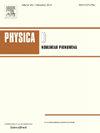Braided Gelfand–Zetlin algebras and their semiclassical counterparts
IF 2.9
3区 数学
Q1 MATHEMATICS, APPLIED
引用次数: 0
Abstract
We construct analogs of the Gelfand–Zetlin algebras in the Reflection Equation algebras, corresponding to Hecke symmetries, mainly to those coming from the Quantum Groups . Corresponding semiclassical (i.e. Poisson) counterparts of the Gelfand–Zetlin algebras are described.
编织Gelfand-Zetlin代数及其半经典对立物
我们在反射方程代数中构造了Gelfand-Zetlin代数的类似物,与Hecke对称相对应,主要来自量子群Uq(sl(N))。描述了Gelfand-Zetlin代数的相应半经典(即泊松)对立物。
本文章由计算机程序翻译,如有差异,请以英文原文为准。
求助全文
约1分钟内获得全文
求助全文
来源期刊

Physica D: Nonlinear Phenomena
物理-物理:数学物理
CiteScore
7.30
自引率
7.50%
发文量
213
审稿时长
65 days
期刊介绍:
Physica D (Nonlinear Phenomena) publishes research and review articles reporting on experimental and theoretical works, techniques and ideas that advance the understanding of nonlinear phenomena. Topics encompass wave motion in physical, chemical and biological systems; physical or biological phenomena governed by nonlinear field equations, including hydrodynamics and turbulence; pattern formation and cooperative phenomena; instability, bifurcations, chaos, and space-time disorder; integrable/Hamiltonian systems; asymptotic analysis and, more generally, mathematical methods for nonlinear systems.
 求助内容:
求助内容: 应助结果提醒方式:
应助结果提醒方式:


